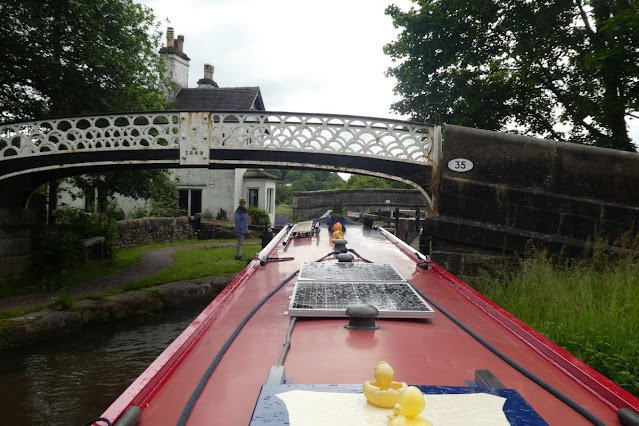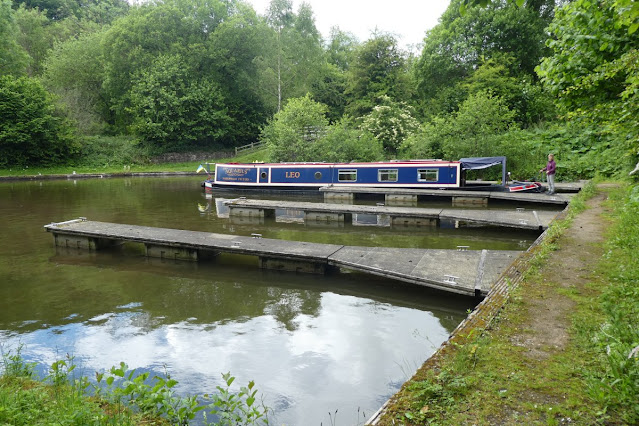We are now down 50 feet from the Trent and Mersey on the River Weaver after coming down the Anderton Lift this afternoon. So I thought it would be interesting to share some photos of our descent. Normally the lift has two caissons each capable of holding a wide beam boat or two narrowboats. Usually one caisson goes up as the other goes down. However at present only one caisson is working so passage is restricted and you need to book passage rather than just turning up and waiting your turn. However we booked our passage only yesterday so there didn't seem to be much problem, indeed a phone call after our arrival gave us the option to go down an hour before we had booked as there was a cancellation. We have however also booked our return for next Monday, so let's hope it's still working then!
Here are some pictures of the process. You have to arrive on the waiting moorings at the top half an hour before the lift time.
 |
Here is the view of the lift from the River Weaver below. The level approach to the right at the top connects with the Trent and Mersey Canal (Anderton is between Middlewich and Preston Brook).
|
 |
Once we were given the 'all clear' we turned into this level section passing under the first of two gates seen here. The industrial works you can see to the left of the lift is in fact on the other side of the Weaver below.
|
 |
Once we were through the gate we stopped, waiting for the cabin cruiser that was supposed to come down with us. For some mysterious reason he missed the turn (how embarrassing is that) and after waiting some time, we went down alone. Beyond Helen on the bow and at water level you can see the barrier that needs to be lifted before we can move forward into the caisson.
|
 |
This view is taken looking back and shows the gate descending and closing off the access to the Trent and Mersey behind us. Presumably this is so that, if something goes wrong then the lift does not drain the canal.
|
 |
Here is a view looking down to the River Weaver some 50 feet below us. The view is looking upstream towards Northwich.
|
 |
Once the water gate in front of us was raised the lift attendant beckoned us into the caisson. A gap between the double gate behind us was then emptied of water and the two linked gates separated so that the caisson with its water can be lowered. Here we are still at the top - notice the white railings to our left and compare that to the next photo.
|
 |
| This photo is taken part way down and you can see the white railings are now above us. The movement is extremely smooth and slow and it is easy not to notice that you are going down. I did try to post a video showing just how slow the descent is, but unfortunately it doesn't seem to work on Blogger. It takes about 10 minutes to go down but that is a lot quicker than 5 or more locks. |
|
|
 |
Here is a view looking up once we were near the bottom of the lift at River level. Through the grill overhead you can see the gear wheels that used to work the lift when each caisson was suspended by cables from the top. The lift started life as hydraulic and was later converted to electricity with cable suspension because the river water corroded the hydraulic rams. Finally in 2002 it was converted back to hydraulic power with high tech ceramic rams below each caisson. It appears that erosion of the surface of the ram is once again causing problems and is the reason the west caisson will be out of action for the rest of this season.
|
 |
Here again looking up you can see the gear and pulley wheels.
|
 |
I took this view looking back as we drove Leo out of the lift at the bottom, having waited for a similar double gate to be lifted. You can see the right hand caisson is open where we have just left.
|
 |
And here once more is the picture from down below showing this wonder of the waterways with its Victorian engineering.
|
So we hope that was interesting and now look forward to a few days on a river. We've been on the Weaver before and it is certainly worth a visit. After we return to the Trent and Mersey we will be heading north to Liverpool.
































